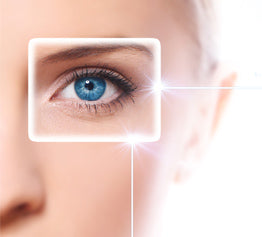NZ OWNED & OPERATED
Optimal Optics

Vision problems are multiplying at epidemic proportions in our society. Over half of the population over 75 years of age has either cataracts, glaucoma, or macular degeneration. These disorders rob people of their vision every year. The eyes use one third as much oxygen as the heart, need ten to twenty times as much vitamin C as the joint capsules involved in the movement of our extremities, and require more zinc than any other organ system in the body.
What causes eye damage and disease?
One of the main culprits that negatively impacts eye health over time is overexposure to harmful wavelengths of blue light. Human eyes are exposed to blue light all day long, and at ever-increasing levels due to the prevalence of smartphones and tablets. The eyes can't filter blue light on their own, and overexposure may lead to poor vision.
Controlling blood pressure is not just a good idea for your heart, it is also a good idea for protecting our eyesight. Diabetes and high blood pressure increase your risk of eye disease and vision loss, and must be controlled for maintaining eye health as we age. High blood pressure can increase the risk for glaucoma and also increase the risk for diabetic retinopathy if one has diabetes.
When pharmaceutical medications are taken for conditions of the body, they often have visual side effects. For example, there are more than 300 drugs that can accelerate the formation of cataracts. Medications that lower cholesterol affect the liver, and cortisone inhalers, antihistamines, and even Viagra affect the eyes.
The liver is the key organ for the health of the eyes, as all nutrients pass through the liver and the fat-soluble vitamins - A, D, E and K – and the antioxidant glutathione are stored in the liver. The liver and eyesight are intricately connected, therefore when the liver is overburdened, eyesight will be compromised.
Eye Health Nutrients
Vitamin A (beta-carotene) is necessary for maintaining healthy vision and protecting ocular (eye) tissues from oxidative (free radical) and degenerative damage.
Vitamin C (ascorbic acid) protect the eyes from UV radiation and oxidative damage, which helps to prevent cataract formation.
Zinc (gluconate) plays an integral role in maintaining normal eye function. Research suggests suboptimal zinc status may influence the development and progression of several chronic ocular diseases.
Selenium (amino acid chelate) functions as an antioxidant to protect the lens and retina from oxidative damage. Maintaining normal glutathione levels is especially important to ocular health, since deficient glutathione levels is one of the factors contributing to cataract formation.
Lutein (marigold flower extract) and Zeaxanthin are essential for maintaining vision, acting as a powerful antioxidant and protective pigment to reduce oxidative stress-induced damage, filter ultraviolet (UV) and blue light, and help prevent vision loss from AMD and other ocular diseases.
Copper - has a variety of health benefits, including improving eye health and helping to inhibit the progression of advanced age-related macular degeneration. Copper, acting as an antioxidant, encourages the development of flexible connective tissue for proper eye structure. It binds with zinc, and the two should be supplemented together. Copper is added to eye formulas to prevent copper-deficiency anemia, which can occur if large amounts of zinc are consumed
Apple fruit extract (Malus pumila) Results from the AREDS studies demonstrated that antioxidant therapy could reduce progression of AMD by 25%.
Alpha-carotene - Higher intakes of alpha-carotene have been shown to be associated with reduced risk of advanced AMD.
Lycopene - Studies have shown those with the highest plasma concentrations of lycopene exhibited the lowest risk of cortical cataracts.
Cryptoxanthin - A study with senile cataracts, cryptoxanthin appeared to serve as a protective variable for risk of cataract, with lower concentrations of cryptoxanthin associated with cataracts in people under 61 years of age.
Turmeric root extract (Curcuma longa) contains curcuminoids which exhibit potent antioxidant and anti-inflammatory activity and have potential therapeutic efficacy in ocular diseases such as dry eye syndrome, glaucoma, retinopathy, and anterior uveitis.
Green tea leaf extract (Camellia sinensis) is a rich source of antioxidant nutrients, including epigallocatechin-3-gallate (EGCG) known for its anti-inflammatory properties which research suggests may be potentially beneficial for the treatment of inflammatory ocular diseases such as dry eye.
Bilberry fruit extract (Vaccinium myrtillus) contains potent antioxidants been found to enhance microcirculation to the eyes, strengthen retinal capillaries, reduce retinal inflammation and prevent oxidative damage.
N-Acetyl-l-Cysteine (NAC) a precursor to glutathione, stimulates glutathione synthesis in the body and has been shown in both animal and human studies to raise glutathione levels—glutathione deficiency is a causative factor in cataract formation.
Taurine appears to play a critical role in maintaining cellular integrity of the retina and preventing oxidative stress-related neuronal damage and retinal degeneration.
Quercetin has been shown to have potent antioxidant and anti-inflammatory effects and may have therapeutic potential for the treatment of inflammatory ocular diseases and cataract prevention.
Grape seed extract (Vitis vinifera) helps improve vision, shown to slow and/or inhibit formation of cataracts and can protect ocular cells from the damaging effects of oxidative stress
Olive leaf extract (Olea europaea) has demonstrated aldose reductase-inhibiting activity - aldose reductase is an enzyme involved in the formation of diabetic cataracts or "sugar" cataracts.
Sodium copper chlorophyllin - Research indicates that chlorophyll prevents oxidative damage to cells by reducing reactive oxygen species (free radicals) and chelating metal ions.
Nature’s Sunshine Perfect Eyes was inspired by the Age-Related Eye Disease Study (AREDS) and contains these powerful antioxidants and nutrients that help prevent and reduce oxidative stress-induced damage to the eyes and have been shown to help prevent or slow the progression of common vision disorders such as cataracts and age-related macular degeneration (AMD).

